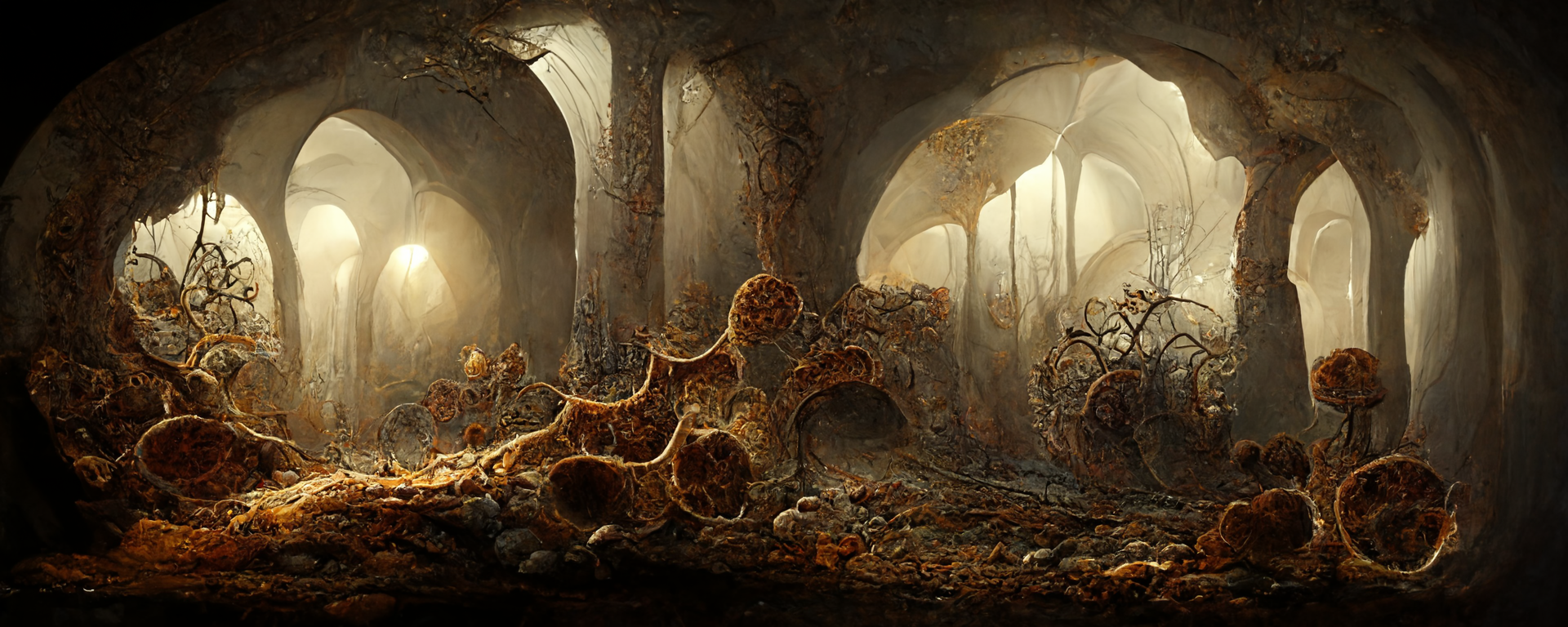Underneath the boney deserts of Kajh-Tai, one of the Kajh's oldest mines sprawls through long veins of corralum chambers, some of which are 40m tall at their highest. Most of the mine is lit with Amberchrys Glowbulbs—which also happen to be the second-most prevalent product of the material these mines were made for.
Exuded from the surface dermis of healthy Amberge Coral (WT), Amberchrys is a semi-translucent sap that collects in deposits ranging from tiny beads to meters-wide blobs. Fresh amberchrys is semitacky, but the floors of the corralum are covered in swizzling patterns and structures of Amberchrys stalagmites.
Greater Amberge Mines
Camps
Throughout the mines. large furnaces are used to calcinate the larger impurities from the Amberchrys
These are exuded in a few different shapes depending on whether they are ready to be sent to the surface or moved further along in processing. From globes, to ovoids, to urns, these "ingots" are often praised for their beauty and used to create urns and other artistic furnishings.
These ingots are to one of the major basecamps, all of which have crucial airship access to the surface. Some will be shipped off to other customers for their personal processing. Some are passed through one of the turbine furnaces at the camp, which are often up to 25m in height.
As previously mentioned, Amberchrys bulbs are one of the top products of Amberchrys. Amberchrys is easily shaped and enchanted, which makes it terrible for secure use but great for domestic commercial use. Even the hardest Amberchrys is softer than Quartz—the favored gem for secure enchantments.
Restricted Zone
Though the mines are foundation of Kajh-Tai's wealth (and the source of greed which drove a slave trade during the reign of the Valuser'ran Supremacy) they were not the first into it.
Miner lore speaks of a temple in the depths of the Amberge Corralums. Some call it a Sepulchre, some an Old Home, but it was there before they arrived, and remains there today, hidden and walled off in a location undisclosed, but guessed at by those who pay attention to where the government tells them they can't go.
Some pictures of it remain. And show a 4m glowing crystal at its heart—this is presumed to be a Divinorium: the storage cask of a physically deceased Monolith.
Reportedly, any entrance into the temple is met with a metaphysical hostility. The Amberchrys flows from the walls with remarkable speed, bubbling with unexpected heat and smothering intruders.
Some claim this is a tall tale, but if you go to the Mother Camp of the whole operation—the mines near Yak'kolithar Lake—you'll find a Shrine dedicated to the disfigured and incomplete remains of a Kajh Psiolic Monolith who dared attempt to breach the chamber to disenchant the crystal.
Many Amberchrys miners make a pilgrimage to the Amber God when starting their careers. Though the Monolith is very dead, it seems that the Amberchrys has preserved enough for their corpse to still produce Meta.
Creatures
The cave also has a very diverse ecosystem of wormy Rutas They mostly prey on each other, and are small enough that thick, strapped cklothing will protect you from all but the worst. Most of the threat they post is to your ability to keep your breakfast down, and your primary interaction with them will be in seeing them feed on one-another on the mossy flora of the caves.
Of greater concern is the Suckermaw Snakes—highly prehensile worms up to 2m in length. They coil around ceiling outcroppings and wait for prey to walk beneath them before swinging their heads down in a wide arc.
Of greatest concern, and interest, are the Spiderpods. Spiderpods are cephalopodic creatures with asymmetric bodies comprised of semirigid tentacles around a cartilaginous skull with a single cyclopean eye socket. Because they use their many legs to spread their weight out across any room they're in, they can reach surprising sizes—up to 3m across.
Center: A spiderpod nymph regards its nesting chambers with a wary, eye. Around it, other spiderpods have taken root in the visceral nests of prey they have constructed. Their bodies harden into dessicated husks as pustule-shaped eggs sprout from their bodies. When these eggs hatch they will be hungry, but too uncoordinated and short to pose a danger to adults or eggs out of reach.
In order to solve the painful challenge of navigating the Corralums—a journey which involves as much climbing as it does walking—Kajh organeers harvest Spiderpod nymphs, reinforce their limbs with mechanical struts, and build a cockpit into their bodies, often replacing many organs with mechanical alternatives or shoving them aside to make room for the cockpit. The cockpit itself has telescopic arms for mining, but motion is handled by the chemically zombified spiderpod, which handles all the fine kinematics of getting from point A to whereever the driver wishes.











Comments